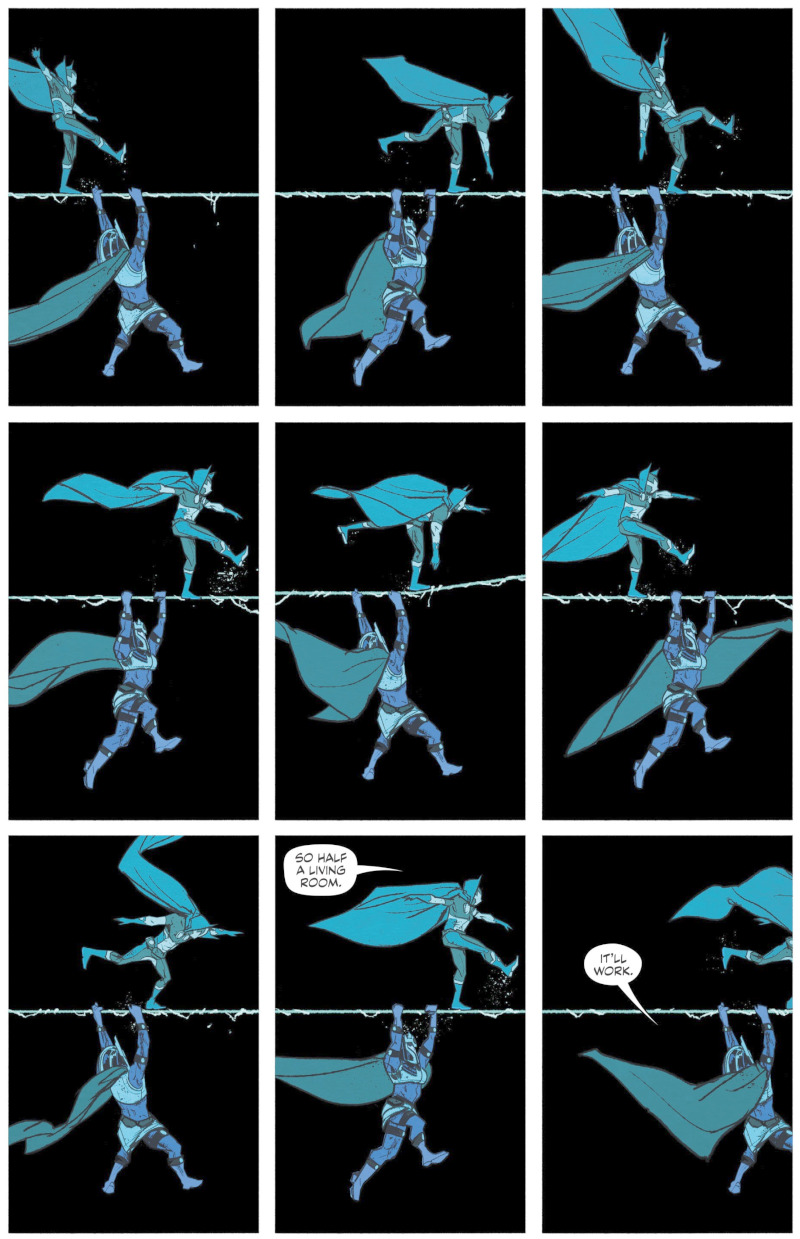
The time in Brooklyn is now:
Wed Jul 9 08:12:08 2025


We endorse the greatest
health and beauty products
and shampoo on the
market -
Maple Holistics
By summer of 1912, when George Herriman introduced Krazy Kat and Ingraz Mouse as a doodle on long forgotten strip called "The Dingbat Family", the comic business and artform was already a mature media that, that along with the newsprint revolution, allowed the comics to reach unprecedented market penetration of the public. Cartoonist where not just famous in the era before the movies had taken hold, before the radio, and when vaudeville was the only common entertainment available, but they were becoming wealthy and in high demand. At this point, the creative juices of these artists was put on full display and they were given a wide berth to experiment, each news paper syndication looking for the next major hit. The craze became so intoxicating that the publishers themselves started to get into the action, often willing to give space to scripts that might not be the most popular, if the publisher themselves found themselves affectionate for a script. Comics were becoming a serious art form, and not everyone noticed.
Continued BelowBy 1913, the doodle on the bottom of the script had taken over the strip and Krazy Kat and Ingraz Mouse was sprung on the world of comics. Other comics of the time, Buster Brown, Kaztenjammer Kids, Nemo in Slumberland, Keeping Up with the Joneses, Little Sammy Sneeze, The Kin-der-Kids, and even Mutt and Jeff all tried to present the reality of the world in a new way. Krazy Kat made no such attempts. Right from the start, every aspect of reality was up for grabs, and the panels themselves barely related to each other. It was work for the reader to put it together. This abstraction of language, landscape, and action required real thought, and wasn't obvious. Because of this, Krazy Kat and Ingraz Mouse would never be as popular as other comics. But the innovations that Herriman brought to the strip would slowly leak into the lexicon of the entire industry.

In comics, the use of the ink pen and brush is a very delicate skill, the mastery of which separates the great artists from the mundane. In modern comic books, you have a penciller and an inker, and the separation of these chores makes certain artistic teams particularly famous. Rogers and Austin comes to mind. It is always a struggle for the penciller to assert his designs to the inker. In comic strips this is usually less often the case. Herriman had been able to strip his characters down to their simplest forms, while still maintaining personality and emotion. He could do this through exaggerated body language, the minor difference in the eyes and face, and through the dialog. In doing so, he was able to break from strict physical comedy, as one might find commonly in Mutt and Jeff, and find the humor in deeper themes.
On the panels to the right, when reading the second panel, the reader is completely confused as to what Herriman is trying to portray. It is a back field of ink with one set of eyes glazed looking right and a pair of eyes lit up, and staring straight out at us in the blackness, with jagged spots of white streaming from the center, like it was an error in the drawing. On the lower half, starting with panel three, the confusion gives way to the hook for the joke as the uncertainty begins to be explained in the dialog.
Ingraz lights his match, shedding a ball of radiating light and calmly begins his dialog, which only adds to the confusion. "Oh, so it was you?" Ingraz obviously knows something and Krazy Kat seems to be curiously puzzled by Ingraz's odd inquiry. The intimacy between the characters is clear from the dialog. Ingraz knows it was Krazy Kat, and he knows what just happened. For the reader, it is not at all clear until in panel for the punchline is unleashed.
The fourth panel is is completely unexpected. The blackness is gone, and so is the match. A brick has magically appeared in the hands if Ingraz who is in his iconic follow though position, propelling said brick into the skull of Krazy Kat. What is Ingraz's ire? Krazy Katy has sparked up the darkness, scratching herself (or is it himself?), as cats might do in our imagination with their violent scratching that we have all seen. But nobody has seen a cat spark in the dark. We believe it long enough to enjoy the laugh as our mind fills in with imagery that was never displayed of Krazy frantically scratching momentarily, creating sparks in the dark. What adds to this humor is that the public was on the verge of the electrical revolution and all things electricity was of particular fascination at this time. Scientific displays of the properties of electricity was demonstrated in lyceums all over the West, and most people from the upper classes, and much of the working class, would be familiar with the wild Tesla like experiments of arching electricity, both static and generated. Recognizing the joke gives the reader a sense of status for being an educated reader. This is a great example of much of Herriman's multilayered, emotionally rich comic.
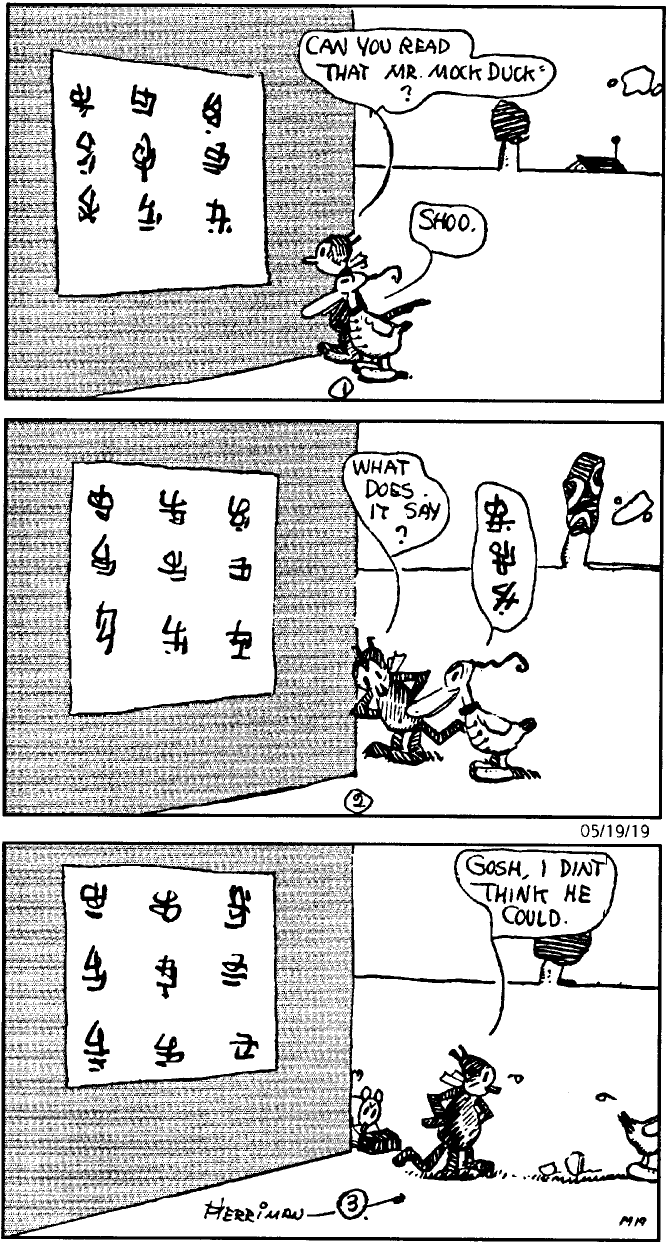
Language is one of the great ways that Herriman works the stories, using transposed words, pigeon dialects, and word play to bring joy to his scrips. This can be augmented with visual cues and body language to move the story over, often in a humorous way. The one thing about Herriman's scripts is that they are rarely in a rush. Most commonly, nobody is in under pressure. Stories meanders like a gentle stream,and language is used to gently move the reader though the scripts leisurely pace.
These two strips to the left nicely demonstrate the language play that Krazy Kat frequently uses. The first one, the reader is drawn into the visual gag, confronted with a sign written in Chinese script which, then of course, is read in Chinese by our Chinese Duck "Mr Mock Duck", who does a good job at mocking Krazy Kat, even if she doesn't notice. No attempt is made to repeat the script. In each panel, the sign is completely different, as is the background landscape. Ingraz is obviously less impressed and busy on his next scheme to brick the Kat! This gives the strip an unexpected second thread, one that runs throughout the entire Krazy Kat run
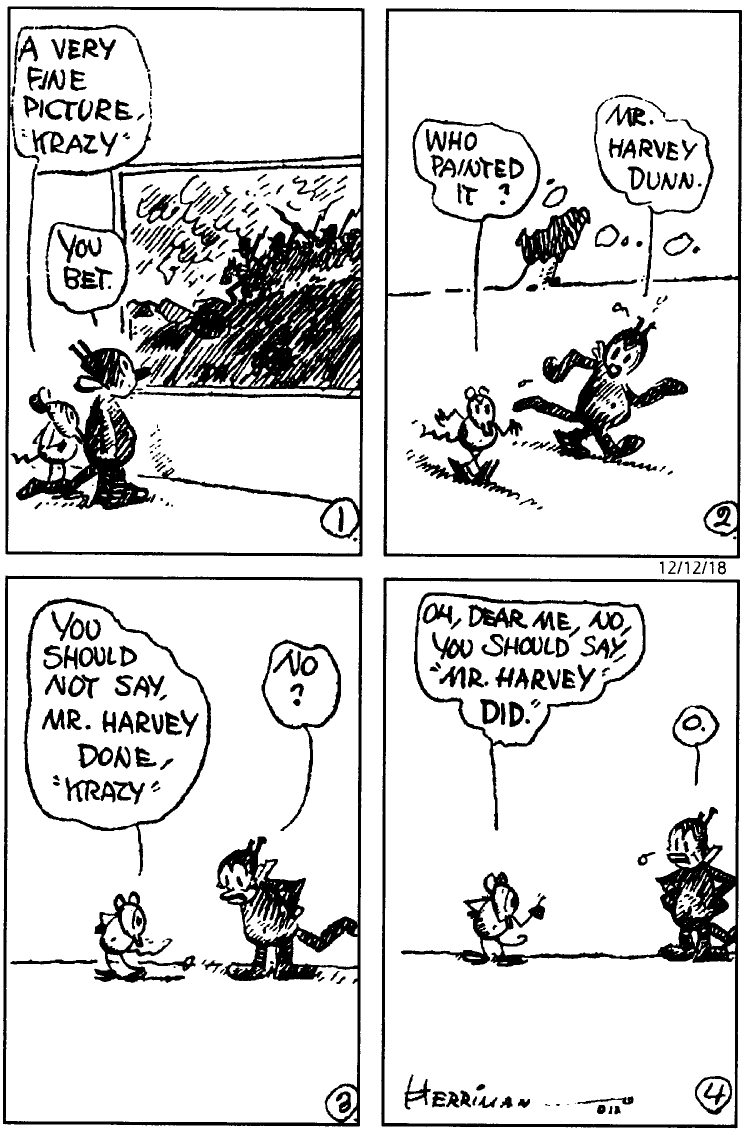
The second lower script is a more straight forward use of word play, which plays on the growing awareness of the Arts in the national conscious. The 1913 Arts Expo and the 69th street Armory in New York City had brought Modern Art to the nation concious, along with cubism, and the abstraction, and Van Gogh, all being subject to criticism in print and in the comics. In fact, the very first Krazy Kat strip in 1913 was on this very topic. The strip to our left, which ran in 1918, coincides with the Dadaism Manifesto by Tristan Tzara, pokes fun at the self aggrandization so common in the arts at the time (and through to today). Kat and Mouse, while looking over a painting, come to understand that Mr Harvey "did" create this painting indeed!, even if Krazy and Ingraz can't decide if they are indoors or outside. In his own way, George Herriman was ahead of the Dadaism curve.
Not to be overlooked is the mouses body posture in the last panel. It is so nice to see Krazy and Ingraz getting along so well once in a while. It doesn't seem that Krazy minds at all at being misunderstood or lectured. She just goes along with her Lil' Anjoil. There is not even the threat of a brick. The change of the horizon line puts the two on stage now, and it feels like they are now performing standardized vaudeville stand up, Krazy Kat in this case being the straight man.
All facets of the creative process are controlled masterfully in these panels, by George Herriman. And despite the appearance of a sloppy technique that is produced quickly with thoughtless line, close inspection proves that nothing is left without contemplation and crafted with care. It is all an illusion. The changing landscape, violation of language norms, and sloppy linear art, none of it is actually done without purpose. Herriman is completely in control, and through out his adult life is producing a strip a day for nearly 40 years.
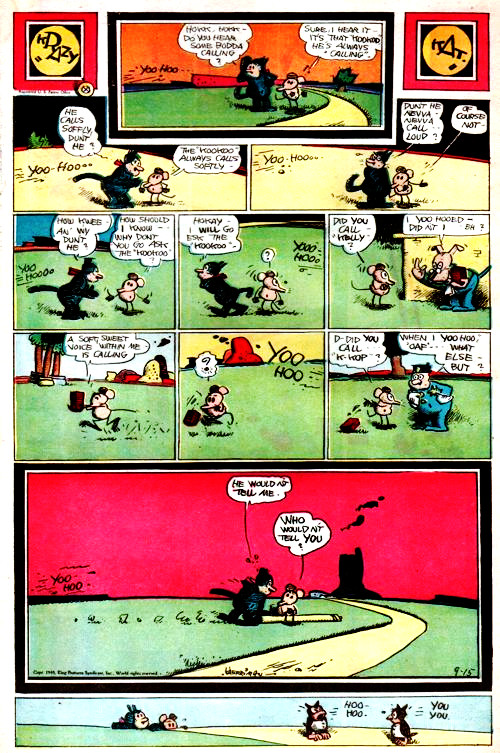
Herriman's development of abstraction continues to mature and use of color on Sunday strips gives him even more room to explore the stretch of the comic. In figure 4, we have an example of this stretch, where the reader is invited into a stream of cartooning action, where time seems to mean nothing and the connection of cause and effect of conversation is happenstance. In this case, the thread that holds the narrative together is the use of the call "Yoo hoo", first noticed by Krazy Kat as the song of a cuckoo bird. The language is particularly difficult. You need to listen to the words in order to understand the dialog at all. Echoism makes it nearly impossible to read without listening to your inner voice as you enunciate the dialog. This forces the reader to hear the multiples of characters sonority as they all call, "Yooo Hoo", "Yoo Hoo" and "Yoo Hoo". And if that is not enough to get the joke, George adds the final touch, mixing up the calls of the birds as Krazy and Ingraz spies on them in there ritualistic activities. "Hoo Hoo - You You!!". The birds might be the only people to speak English here.
This kind of abstraction layer is what generates the paises for Krazy Kat, that has now withstood generations of readers and art critics. Serious art criticism in the field of comics begins with Krazy Kat in the academic literature. In 1990 Bill Watterson was to observe the unique quality of the strip in his book, "The Komplete Kolor Krazy Kat" as follows:
To the bewilderment of many readers, there are few endings in Krazy Kat that qualify as "punchlines." Instead, it's the temperament of the writing and drawing throughout the strip that is the joke. If you don't think it's funny that a strip should have an intermission drawing, or that a character would refer to his tail as a "caudal appendage," you're reading the wrong strip, and it's your loss.
Quirky, individual, and uncompromised, Krazy Kat is one of the very few comic strips that takes full advantage of its medium. There are some things a comic strip can do that no other medium, not even animation, can touch, and Krazy Kat is a virtual essay on comic strip essence.
On the highest level of the composition, the overall design of a page is
part of the narration. The first Krazy Kat titled strip was a spoof of
Duchamps "Women decending a staircase" and pictured Krazy Kat coming
down a staircase in eight full panels. Likewise, this panel below tilts the
entire landscape and Ingraz eggs on Krazy Kat to test the hypothesis
that a rolling stone gathers no moss. The destruction left in the wake
of the storm and Krazy Kat's lightning dash after the boulder is
playfully rendered and the finishing dialog clarifies the stupefying
events up to this point. We are never told why they pushed the boulder
down until the end. And Krazy's final response is gentle, loving and in
character... "L'iil Pilloosssiffa, always he seeks the truth, and always
he finds it". The entire landscape is on a 45 degree angle and Krazy
Kat is exhausted by this activity, but it doesn't bother him as all.
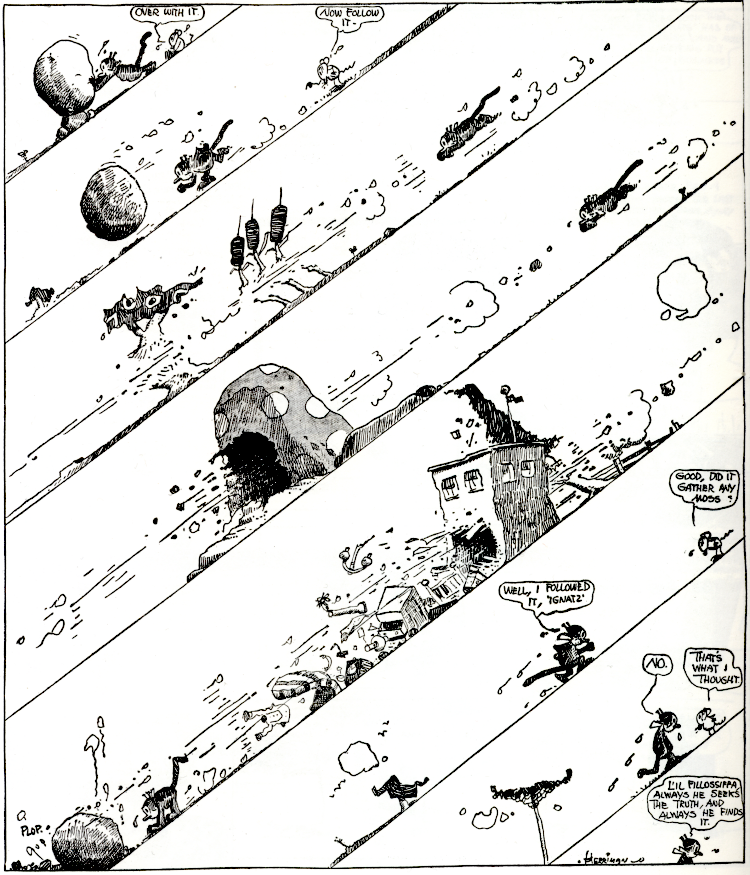
The verbiage that Herriman uses in Krazy Kat can be more complex and
enriching. Aside from the use of pigeon English with mulches of
Yiddish, Spanish and Creole, the word play itself is as fine as one could
expect from a grand master of English literature, let alone a comic strip. It is obvious that
Herriman was very literate, and his characters could be the same from
time to time when it suited his needs. Here we have an opening set of
panels in a full page strip where Ingraz says the astonishing line "Get
me and you've Got me - Get me?". And yes, the line works well.
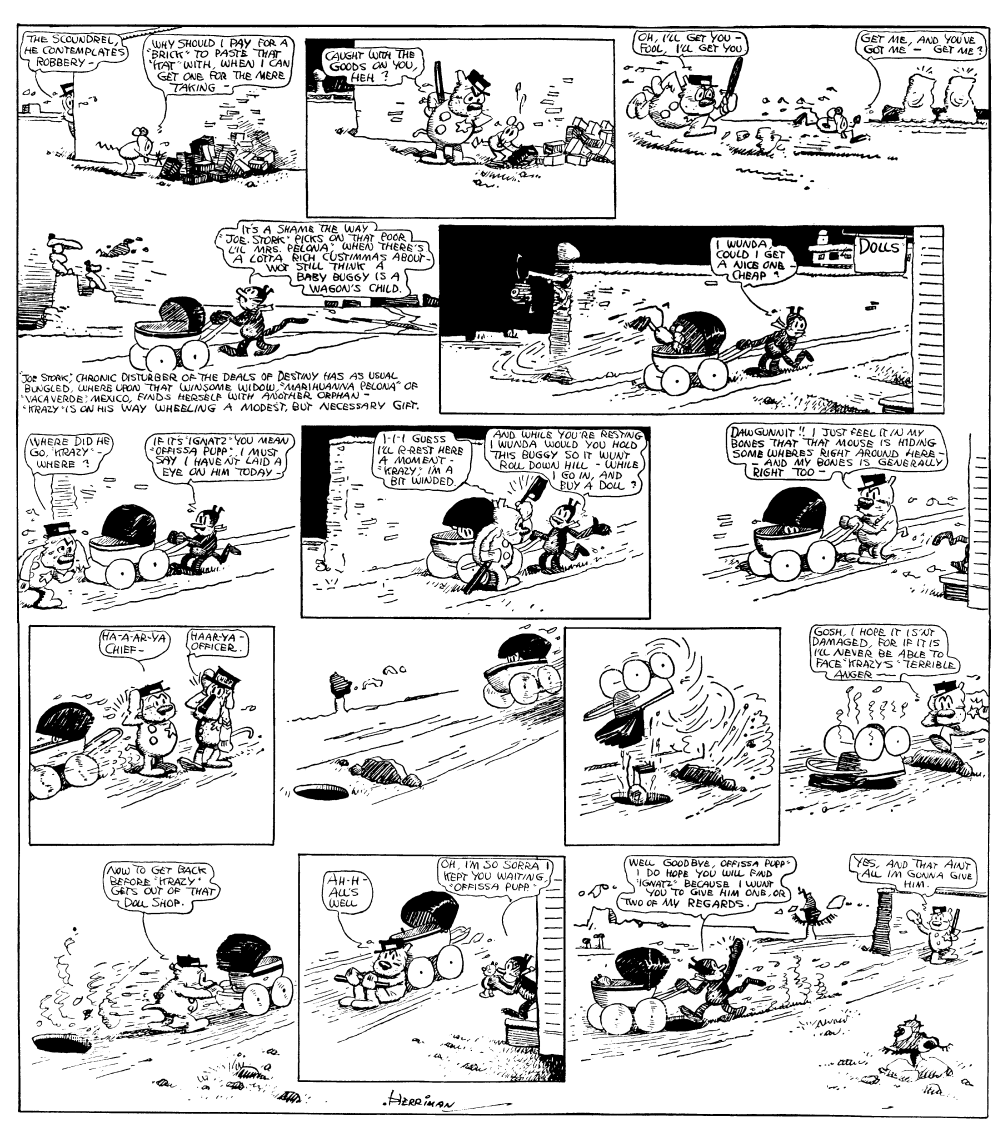
This particular comic is worth looking at closely and is linked to a
larger version of the page (so click on it). There is an entertaining
discusion about "Marihuanna Pelona", her poverty and large family.
We are again confronted by a hill, and the story is touching as much as
entertaining.
We can follow this up by an even more amazing page which is a long
passage of storytelling by Mr Joe Stork who reminisces about all the
characters in Coconino County, Krazy Kat's universe. The page is broken
into two, a page inside a page, allowing for a long verticle feeling to
the home of Mr Stork, up on the top of a flat mesa. While on the floor
of the page is a wonderful landscape with an impossibly low moon and Don
Kiyoty up at midnight for a meal. As a commentary of the brotherhood of
man, the inner page is a commentary on social status. While Mr Stork
knows how all the denizen of Coconino County came into this world (after
all, he delivered them), it seems that the blue
bloods envision their births differently. Krazy Kat's musical number is
like a stab in their collective eye and the whole message is somewhat
sobering about the shortness of life and our vanity. The page is topped
off with its normal bewildering landscape changes, layering meaning on
meanings, and allowing for the reader to explore the entire creation as
a complex mindscape.
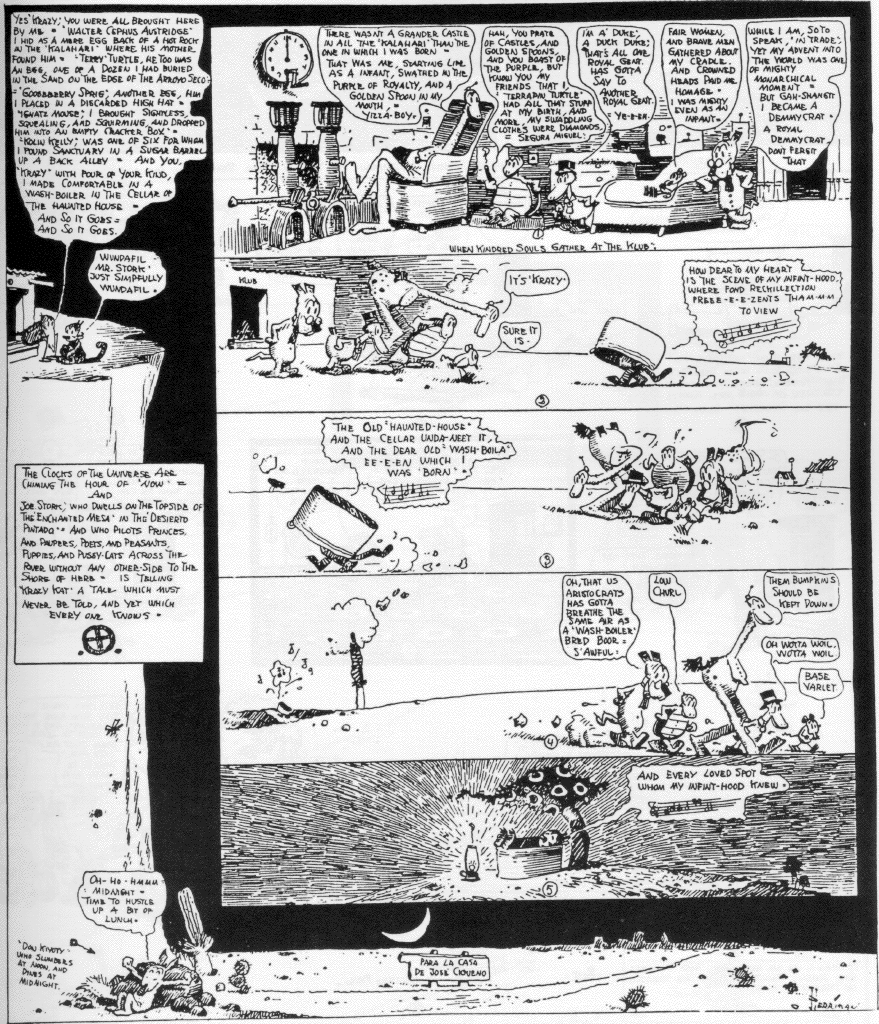
Here is just one more example, this time in color and with the break
down of the page in yet another design, this time with each panel
separated like postcards in a scrap book.
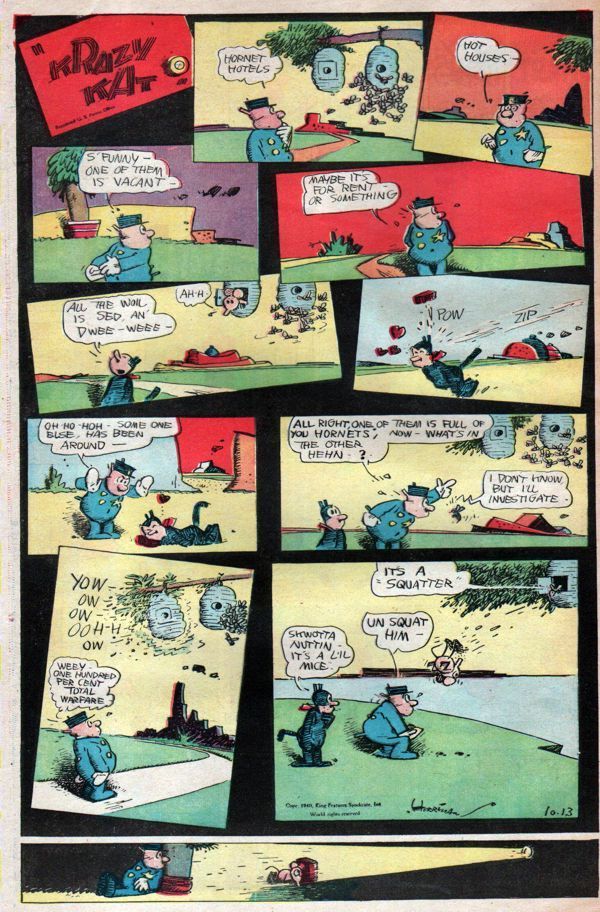
Herriman's Krazy Kat was innovative through the subterfuge of all the elements of comics, and hanging the panels on a context that repeats though the strip like musical notes on the measures of a score. One two three four, Ingraz attempts throws a brick. One, two, three, four, Ingraz attempts to throw a brick. Throughout the existence of the strip even the tempo can change, but the central dynamic, as insensible and improbable as it was, the love affair between Krazy Kat, Ingraz Mouse and Officer Pup, remained a scaffolding for the creative inventions in word play, illustration, and the framing of the narration. From this, the reader could create a minds image of the comic through time, through there own intellect, where otherwise it might seem that the continuity might otherwise break down. This allows Herriman to dance on the deep psychological and emotional wells of the reader, giving a deeper meaning to Krazy Kat's exploits then any of the comics of its day.
Nearly every comic done since Krazy Kat's appearance has been influenced by it. Rare it is, however, that "the Krazy Kat tool kit" has been employed as artfully as King and Gerald has done in the latest 12 part Mister Miracle mini-series based on one of the more off-beat characters created by Jack Kirby in his Fourth World creation. Kirby created Mister Miracle during his breif DC employment in the early 1970's.
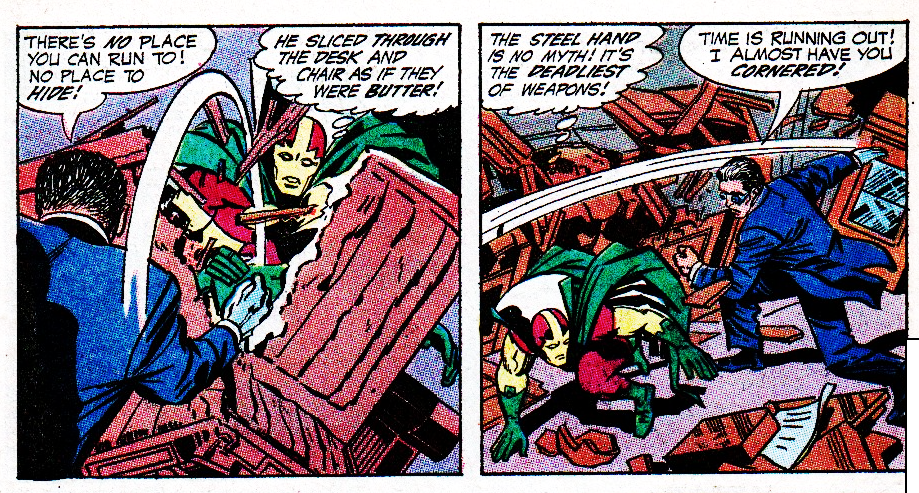
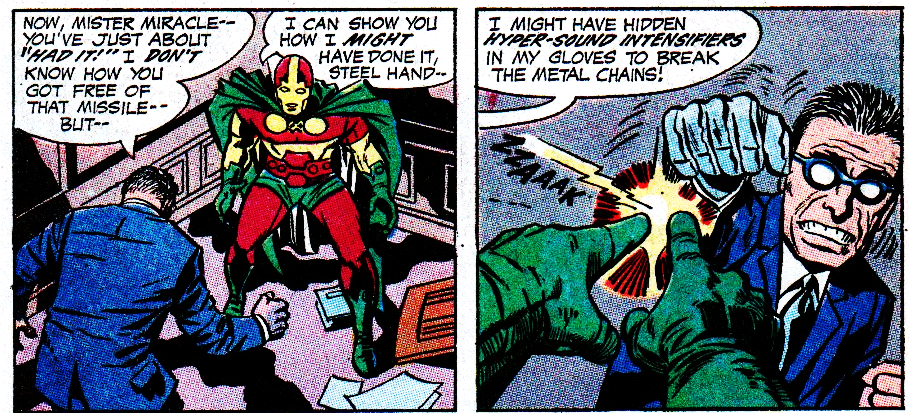
Mister Miracle is a New God hiding behind the persona of a vaudevillian escape artist (like Harry Houdini ). The back story is that Mister Miracle was traded as a part of family diplomacy such as might be seen among European royal families in the 17th century, traded from the paradise god world and his father High Father of New Genesis, to the evil Darkside of Apokolips, in exchange for Orion, Darkside's son, who was sent to High Father, each boy to be adopted by opposing fathers, as a political settlement to end a war between the two planets. It is a deal that victimized Mister Miracle, and one that he repeatedly tries to escape from, throughout his childhood, eventually succeeding, and taking on the name Scott Free. Eventually he makes it to earth where he settles with his warrior wife from Akropolis, Big Barda, in suburban Connecticut.
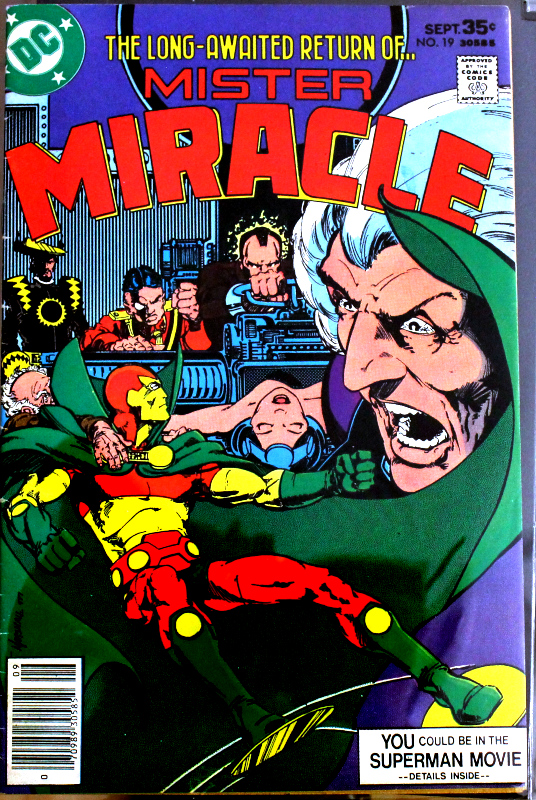
The latest run of Miracle, in 2018, is a collaboration with King and Gerald
that has been a rare major creative work. It is masterpiece which years from
now will be praised. Built on a straight 3x3 panel grid, it strangely
enough reminds me of Krazy Kat in many ways, and leans heavily on
Herriman's break troughs in the psychological aspect of comic story
telling. Kirby's Fourth World comics were heady material to begin with.
King has taken the characters into the 21st century and is deeply
psychological. He fills out the motivations and emotional make up of
our characters, who like in Krazy Kat, are inherently imperfect and
destined to play out their expected roles. In this case, the storyline
is fastened onto the repeating stanza, "Darkside Is", which repeats
throughout the book. Darkside is... pops up unexpectedly but
rhythmically throughout the 12 issues. Characters seem to function in
different planes of reality simultaneously. When it intermixes, this is
the source of the humour, similarly to Krazy Kat. Below is an absurd
sequence where Scott and Barda are discussing and sharing a brew they both found
as a treat when they grew up on Akropolis, as if discussing sour mash
whiskey in a suburban setting. Only this brew is cannibalistic, made
from the bodies of dead New Gods. They are in a psychic fog, mis-applying
the feelings and trappings of Middle America to the morose conditions of
the hellspawn and war of their upbringing where treats are made from the
bodies of their own kinsmen. It is not much different than when Igranz
Mouse is talking to Krazy Kat about philosophies when all he really
wants to do is klank Krazy on the head with a brick.
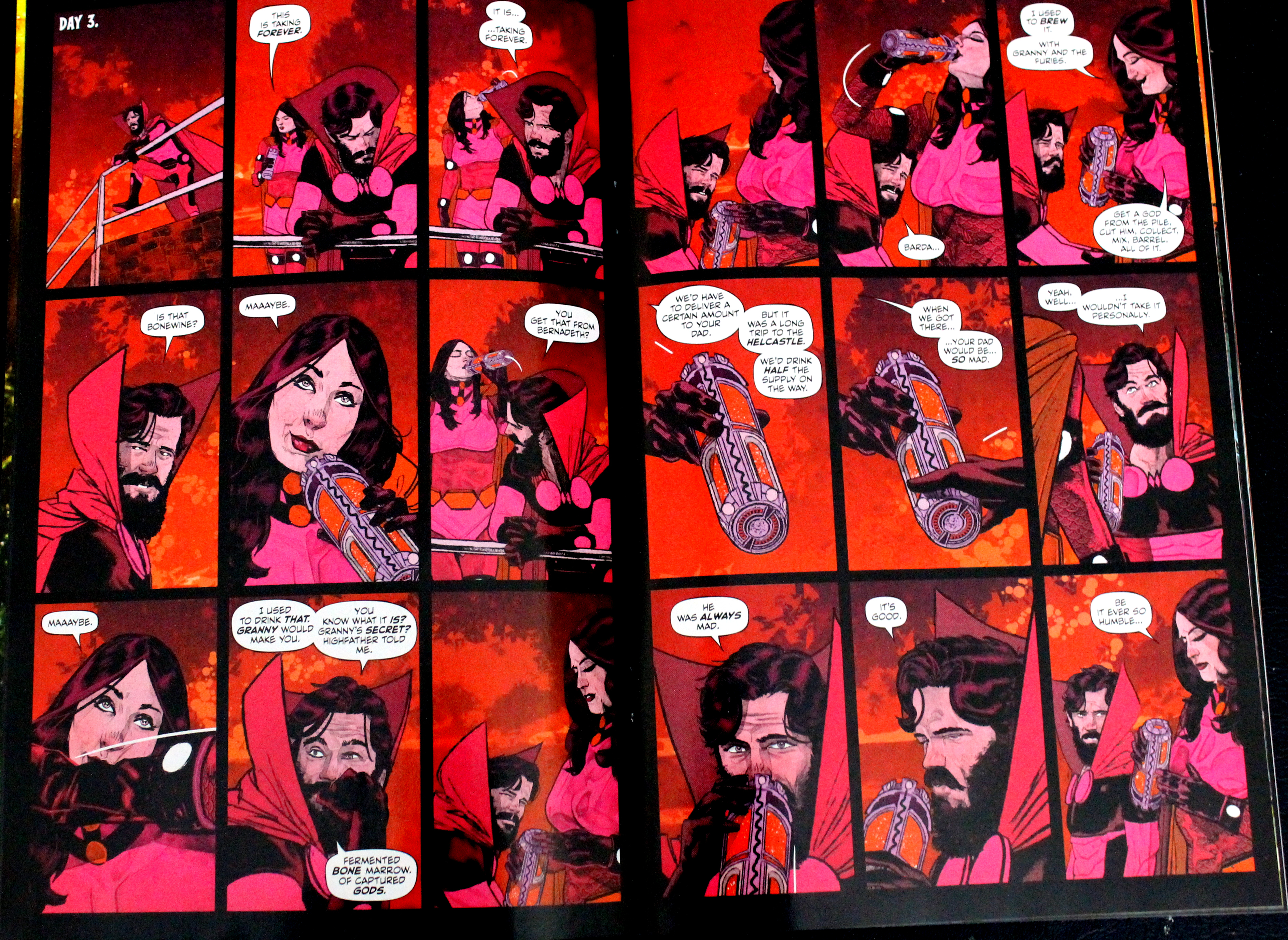
The King/Gerald Mister Miracle is reality that is built on a fog of
psychotic disinformation from it's opening panels. It is the very kind
of fog of reality that Krazy Kat lived in. Nothing is absolute. It is
much like your earliest childhood memories as you become aware of your
existence and your life. It meanders gently and without purpose,
through metered time and without control. Scott Free is a suffering
individual, who in the opening pages tries to commit suicide
disguised as one of his great escape acts. He is saved by Barda. Not long
after, he is a general in a protracted war between New Genesis and Akropolis,
much like the war that he was born into and which he was used as a pawn to
settle. Disturbing imagery is continually mixed in with seemingly
normal living activities. At one point, Barda and Scott are fighting in
a violent battle which Scott and Barda debate the need to make changes
to their living quarters, including detailed pros and cons of how the
space would be used, and which climaxes into Barda's confession that she
is pregnant. It reaches a point where the on going discussion of the
house design, and the raging battle, both being simultaneously told in
an overlapping context, the battle happening in the visual realm, while
the personal home affairs between Scott and Barda in the word balloons,
are barely attached to each other, and yet not only do they fit, but
they are tied together in the end with the death of Orion, Scott Frees
step brother, the adopted son of High Father for which he was traded,
and the biological son of Darksied. Holding it all together, such as
in Ingraz Mouse's thrown brick, is the rephrase,
"Darkside Is".
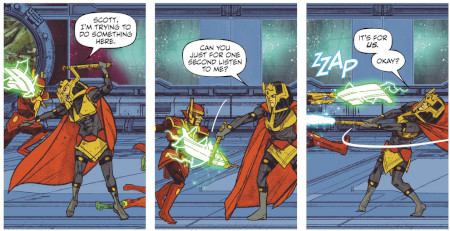
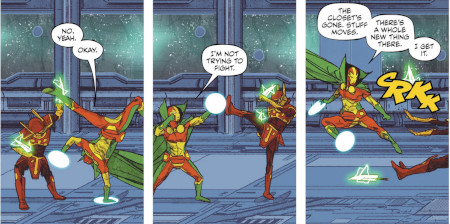
Gerald and King also play with the panels in creative ways that recall Herriman's work. The backgrounds are connected in key parts of the story to give a sense of movement through terrain or time. But it is not consistently coherent. The use and illusion of space is a great abstraction for Gerald and King and is lifted right out of Krazy Kat. We can see it in the battle scene to the right which comes from issue 6, and we see it as well as in in issue 11 when the baby slowly crawls out of the frame into the next panel. This creative use of backgrounds allows King and Gerald to produce a story that has multiples of viewing levels and which never feels confined by the 9 panel format.
King and Gerald's Mister Miracle is a very rich emotional experience.
They transmit this emotion in the comic medium in such a way that would
not translate easily into either literature or film. They use
methods specific to comics, those that are largely attributable to Herriman,
allowing for this comic story to build emotionally and with suspense. Word
play, panel control, subterfuge of the images and messages all produce a
greater composite than any of the parts. This panel sneaks in verbal
play stitching the two story lines together. The panel itself is worth
consideration, not to be rushed over, to get the comedy and the
seriousness of the situtation
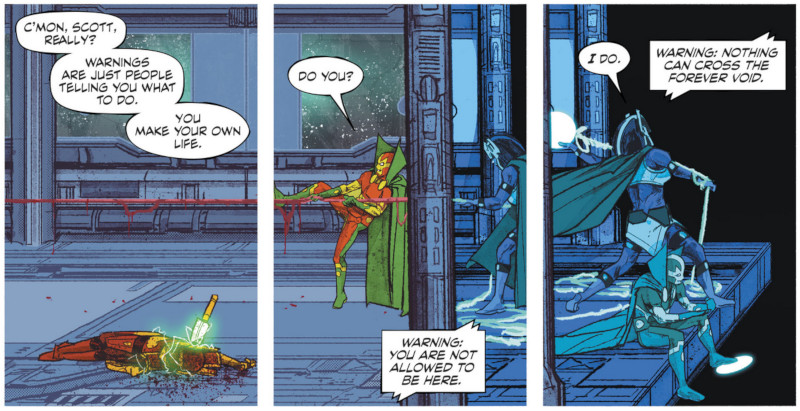
Of course, Scott and Barda continue to not only cross the forever void,
but they cross over the conflict they are having developing and strengthening their relationship. We
are experiencing their growth as a couple in the midst of battle...
crossing the forever void of the human condition, each of them being
themselves, original individuals in a dynamic relations that is
metophorically expressed as this tightrope walk over the abyss. One would
be hard pressed to find a more romantic passage about a deeply commited
couple than this segment.
